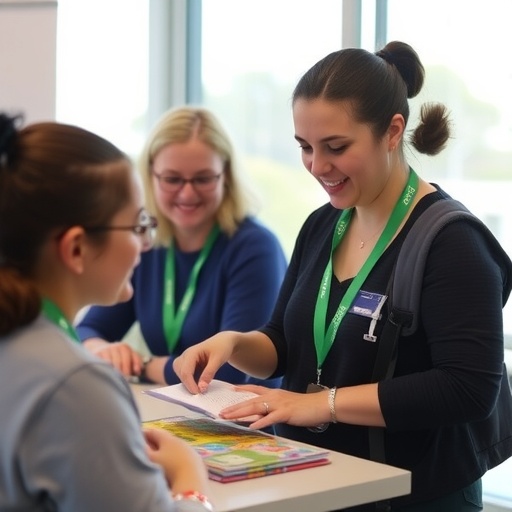In an innovative study spanning over a decade, a team of researchers has meticulously examined the evolution of research capacity and capability among allied health professionals within a regional public health service in Australia. This groundbreaking investigation, encapsulated in their recently published article, sheds light on how structured frameworks and strategic initiatives can enhance the skills of health professionals, ultimately leading to improved patient care and outcomes.
The healthcare landscape is perpetually shifting, with the demand for advanced research acumen becoming crucial as complexities within public health continue to evolve. The research conducted by Pain, Saurman, and Brown highlights the critical need for allied health professionals to adapt and expand their research capabilities to tackle contemporary health challenges effectively. In their work, the team utilizes a blend of qualitative and quantitative methodologies to offer a comprehensive analysis of the gains made in the sector from 2011 to 2023.
One pivotal aspect of the study is its exploration of the specific strategies that have driven growth in research capacity. Training programs designed explicitly for allied health professionals serve as a foundation for this development. The authors detail how targeted workshops and mentorship networks created an environment conducive to collaborative learning and shared experiences. This approach not only cultivates individual skills but also enhances overall team dynamics, leading to more effective research outcomes.
Moreover, the researchers emphasize the importance of institutional support in fostering a culture of inquiry and innovation within healthcare settings. Administrative backing, funding, and a clear vision for the role of research in public health are essential components that have facilitated this growth. The paper outlines the journey taken by practitioners as they navigated challenges and seized opportunities, showcasing real-world applications of theoretical frameworks in action.
What stands out in the research is the recognition of varying levels of engagement among allied health professionals in research activities. The authors categorize these levels of engagement, providing a nuanced understanding of how enthusiasm and investment in research can fluctuate based on individual experiences and available resources. By illuminating these differences, the study advocates for customized interventions to support professionals at various points on their research journey.
As the landscape of healthcare continues to be reshaped by technological advancements and demographic shifts, the study’s findings suggest that prioritizing research capacity among allied health professionals is not just beneficial but necessary. Through their research, Pain and colleagues argue that developing a robust research culture will contribute significantly to the agility and responsiveness of public health services, enabling them to address emerging health crises with adeptness.
In addition, the authors explore the role of community engagement in enhancing research relevance and applicability. Research driven by community needs has the potential to yield practical solutions that can be implemented effectively within local contexts. By integrating patient voices and stakeholder perspectives into research agendas, allied health professionals can ensure that their work resonates with the populations they serve, thereby increasing the impact of their findings.
The study also engages with the potential barriers faced by allied health professionals in integrating research into their daily practice. Time constraints, limited access to resources, and insufficient institutional recognition often hinder the pursuit of research activities. Pain and his collaborators present these hurdles candidly, providing insights into how they can be overcome through proactive institutional reforms, policy changes, and dedicated support systems.
Looking ahead, the authors advocate for a continued commitment to building research capacity not only within the allied health workforce but also across the broader healthcare spectrum. As the profession evolves, it is imperative that future initiatives remain focused on sustainable growth, adaptability, and resilience in the face of ongoing challenges. This forward-looking perspective is vital as public health entities strive to maintain their relevance and effectiveness in a rapidly changing world.
One of the remarkable elements of this research is the comprehensive evaluation framework employed by the authors. Through rigorous assessment of both qualitative and quantitative data, they present a multifaceted view of progress. This methodological rigor enhances the credibility of their findings and provides a template for similar evaluations in different healthcare contexts.
Ultimately, the research culminates in a compelling call to action for health policy makers and educational institutions. By prioritizing investment in research capacity for allied health professionals, stakeholders can not only uplift the workforce but also enhance the quality and efficacy of public health initiatives. The implications of these findings extend beyond Australia, offering a blueprint for global health systems grappling with similar challenges.
As the publication gains traction, it is expected to inspire further academic inquiry, stimulate dialogue around best practices, and galvanize collaborative efforts among health professionals. The research not only contributes to the academic literature but also serves as a strategic guide for allied health professionals intent on navigating the complexities of research in their field.
In summary, the trajectory observed in the study highlights a profound shift in the landscape of allied health research capabilities. By effectively measuring and analyzing growth over time, Pain, Saurman, and Brown contribute vital insights that can inform practice and policy in the years to come. Through their work, they illustrate the transformative potential of empowering health professionals with the necessary tools to engage actively in research, ultimately aiming for enhanced health outcomes for communities at large.
As this research begins to circulate within academic circles and the broader health community, the implications are poised to resonate with practitioners, educators, and policy makers alike. It stands as a testament to the power of collaborative research in fostering growth and propelling the allied health sector forward in addressing the multifaceted challenges of modern public health.
The comprehensive evaluation and detailed recommendations presented in this study make it an essential reading for anyone invested in the future of healthcare research. The authors’ insights and reflections pave the way for a more informed and capable workforce, ready to tackle the health challenges of tomorrow with expertise and confidence.
Subject of Research: Measuring growth in research capacity and capability of allied health professionals at a regional Australian public health service
Article Title: Measuring growth in research capacity and capability of allied health professionals at a regional Australian public health service: 2011–2023
Article References:
Pain, T., Saurman, E., Brown, A. et al. Measuring growth in research capacity and capability of allied health professionals at a regional Australian public health service: 2011–2023.
BMC Health Serv Res 25, 1378 (2025). https://doi.org/10.1186/s12913-025-13187-6
Image Credits: AI Generated
DOI: 10.1186/s12913-025-13187-6
Keywords: Research capacity, allied health professionals, public health, training programs, community engagement, healthcare improvement, institutional support, qualitative analysis.
Tags: Allied health research in regional AustraliaChallenges in contemporary public healthcollaborative learning in healthcareEnhancing healthcare outcomes through researchGrowth of research capacity in allied healthHealth professional development initiativesImpact of mentorship on health researchimproving patient care through researchPublic health service evolutionQualitative and quantitative health research methodologiesStrategies for enhancing health professional skillsTraining programs for allied health professionals





